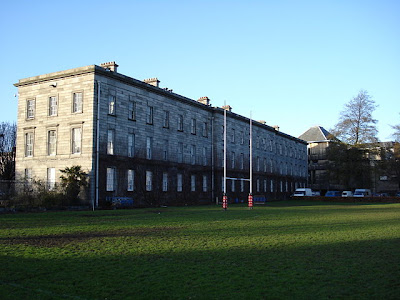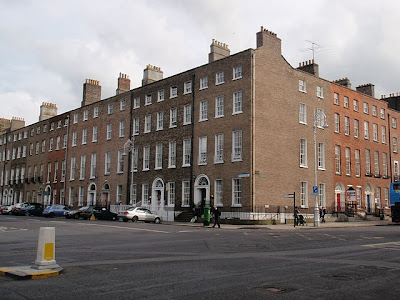Dublin (Irish: Baile Átha Cliath, "which hurdled Ford City") is the capital city of Ireland. Vibrancy, nightlife and tourist noteworthy, and it is the most popular entry point for international visitors to Ireland. As a city, it is disproportionately large for the size of the state (2011 pop Greater Dublin Region 1.8 million.), More than a quarter of the population living in metropolitan areas of the Republic. The center, however, is relatively small and can be navigated by foot, with most people living in the suburbs.
 |
| Trinity College Football Dublin, Ireland |
History - Founded in 841, Dublin was originally settled by Vikings in the Celtic tribal population. In the 9th century Denmark captured Dublin and had control until 1171 when they were expelled by King Henry II of England. In the 14th century king of England controlled Dublin and nearby area known as the "Pale".
When the English Civil War ended in 1649, Oliver Cromwell took over. Dublin experienced massive growth and development in the 17th century because many Protestant refugees from Europe came to Dublin. In the 17th century Dublin is the second-largest city, just behind London, and the period when large Georgian building was built which still stands today. Georgian architectural style was popular during 1720-1840 when George I, George II, George III, and George IV of England was governed.
In 1800, the Law Union between Britain and Ireland abolished the Irish Parliament. From this point, the Irish worked to gain their independence from the British, which they eventually won in 1922. Easter rising in 1916 and the War of Independence greatly helped Ireland win their freedom. One incident remembered as a key moment in Irish history is the Easter rising in 1916.
A failed attempt to take over some important buildings, including the General Post Office on O'Connell Street, led to the arrest and execution of hundreds of 15, is now considered a martyr for the cause. Many believe that this event helped gain sympathy for the struggle for independence from Britain.
 |
| Dublin Ireland |
Dublin is divided by the River Liffey. On the north side of the Liffey is O'Connell Street - the main highway, which intersects with a variety of shopping streets, including Henry Street and Talbot Street. On the south side are St. Stephen's Green, Grafton Street, Trinity College, Christ Church, St Patrick's Cathedral, and other attractions.
Dublin zip code range from Dublin 1 to Dublin 24. As a rule, odd numbers are given to the area north of the Liffey, while even numbers are given to areas south of the river. Typically, the lower the zip code, closer to the city center.
If you are already in the city, the main office, located in the St Andrew's Church just off Grafton Street in the city center (Dublin 2), is a good place to start for information. You can book accommodation and tours there, as well as looking for general information on where to go and what to do.
Although some of the best Georgian architecture of Dublin was destroyed in the mid-20th century, a number of which remain outstanding. They are reminders of past British imperialism and drawn without regard to its beauty and architectural significance. They were replaced with modernist office blocks or potpourri, St Stephen's Green (Dublin 2) being a prime example. Fortunately, attitudes have changed significantly, and Dubliners are now rightly proud of their impressive buildings from all eras.
 |
| Merrion Square, Dublin, Ireland |
Climate - Being subject to the moderating effects of the Atlantic Ocean and the Gulf Stream, Dublin known for its cool climate.
Contrary to some popular perceptions, the city is not particularly rain. The average annual rainfall is only 732.7 mm (28.8 in), is lower than London. However, rainfall is distributed more evenly so that on many days there could be a light shower.
Winter in Dublin relatively mild when compared with cities in mainland Europe-daytime temperatures generally range from about 5 ° C (41 ° F), but the ice was common during the period November to February when night time temperatures dipping below 0 ° C (32 ° F) freezing point.
Snow does not happen, but it is not very common, and most of the winter precipitation Dublin comes in the form of freezing rain and sleet. The lowest temperature recorded in the city was -12 ° C (10 ° F). It should also be noted that during the first week of January 2010, the canals froze for the first time in several years - this is a pretty common look back on the 1960s, 1970s and 1980s. Dublin can be said that the climate is very comparable to that of the northwestern United States and southwestern Canada, and many western European coast.
Summers in Dublin are also mild. The average maximum temperature of 19 ° C (66 ° F) in July, much colder than most American cities coldest. Hottest temperature ever recorded in Dublin is only 29 ° C (87 ° F), which is in many other parts of the world, even on its own latitude, just a typical summer day. Do not plan too many activities for the summer heat. Lightning also does not happen very often in Dublin, on average only four days a year. Overall, the city's climate is mild but it will be drier and cooler than the west and south of the island of Ireland.
Image Credit : commons.wikimedia.org
Article Source and See more : wikitravel.org/en/Dublin
Posted by , Published at 5:51 AM and have
0
comments
No comments:
Post a Comment